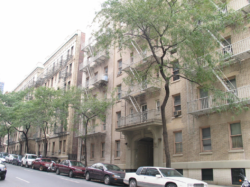
City and Suburban Homes Company, First Avenue Estate. Image credit: LPC.
Developer claimed that Commissioners irrationally and prejudicially analyzed hardship application, and that designation amounted to an unconstitutional taking. In 1990, Landmarks designated the City and Suburban Homes Company, First Avenue Estate an individual City landmark. The block-sized development is bounded East 64th and 65th Streets and York and First Avenues. Built between 1819 and 1915, it was constructed to provide high-quality housing to low-income New Yorkers in an alternative to crowded, poorly ventilated tenement buildings. The First Avenue Estate is one of only two full-block light court tenement complexes in the City.
The Board of Estimate, in one of its final actions, ratified the designation, but excised two buildings from the 15-building-complex’s eastern edge. In 2006, spurred by the local community board, Landmarks revisited the designations, and amended it to again include the excised buildings. The amendment was supported by the community and elected officials, and unanimously affirmed by the City Council.
The property’s owner, Stahl York Avenue, challenged the re-designation in court, but were rebuffed by County Supreme Court Judge Emily Jane Goodman, who found that Landmarks had rationally considered the buildings’ historical and cultural significance.
Stahl then pursued a hardship application at Landmarks, seeking to demolish and redevelop the two re-designated buildings, claiming they could not garner a sufficient rate of return in income from the two buildings, whose units were undesirable by contemporary standards, and lacked modern safety and security systems. According to Stahl’s analysis, if renovated and renovated the units would earn between negative 2.87 percent and 1.19 percent, far below the minimum standard for a reasonable return, set by statute at six percent. Stahl’s cost approach analysis took into account only the two eastern buildings.
Landmarks rejected the hardship application, finding that a proper analysis accounted for the entire complex, and determined that Stahl could realize a rate of return between 8.68 and 16.93 percent, in varying scenarios. Landmarks found that high vacancy rates in the building were largely due to Stahl’s failure to market the units or list them with brokers.
Stahl filed an article 78 petition challenging the denial of the hardship application. County Supreme Court Judge Michael Stallman upheld Landmarks’ determination as rationally issued. Stallman ruled that the hardship application properly applied to the entire designated lot, as the two buildings were only excluded from the initial landmark designation due to a political compromise by the Board of Estimate, that Stahl had consolidated filings for all buildings on the block for real estate tax purposes, and the two building shared their development history and architecture with the rest of the parcel. Stallman found that Stahl had not met its burden of demonstrating that the property was incapable of generating at least six percent. Stallman wrote that Stahl relied on a number of questionable assumptions, including a 20 percent vacancy rate in a highly desirable neighborhood, and monthly rents of $600 to $888, where nearby comparable units were rented for $1,500 to $2,200.
Stahl appealed the decision, again asserting that Landmark’s decision lacked a rational basis, that Commissioner comments were prejudicial against Stahl, that the designation amounted to an unconstitutional taking, and that Stahl was entitled to money damages. Stahl claimed Landmarks failed to consider the cost of renovations that Stahl would incur, that it erred in its approach to financial calculations, and that the entire complex should not have been considered in determining the rate of return.
The First Department affirmed the lower court’s decision, ruling that the complex was one unit of real property, and one improvement for hardship purposes. The court further noted that Stahl failed to adequately demonstrate that the two re-designated buildings, considered alone, were unable to earn a reasonable return. Landmarks’ approach to analyzing the hardship application was rational, using an income approach used by taxing authorities, and also performed 20 additional reasonable return calculations, some using assumptions favored by Stahl, all of which concluded that the buildings were capable of earning a reasonable return.
The court found Stahl’s claim that prejudicial comments were made by Commissioners to be unsupported by the record, which showed that Commissioners were appropriately conversant with the subjects of their regulation, and demonstrated familiarity with the law and facts surrounding the application.
There was no unconstitutional taking because there was no hindrance on the buildings’ continued use as rental residential properties, and did not result in a complete deprivation of the owner’s economically beneficial use of the property, and the only adverse effect was self-inflicted due to Stahl’s warehousing of rental units.
CIT) Stahl York Avenue Co., LLC v. City of New York, 2018 N.Y. Slip Op. 03653 (1st Dep’t May 22, 2018) (Attorneys: Alexandra A.E. Shapiro, Eric S. Olney, Chetan A. Patil, Paul D. Selver, for Stahl; Zachary W. Carter, Aaron M. Bloom, Claude S. Platton, for City).
By: Jesse Denno (Jesse is a full-time staff writer at the Center for NYC Law.)

